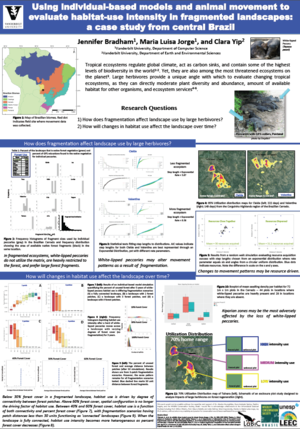Annualmeeting:2017 CSDMS meeting-105
Browse abstracts
Using individual-based models and animal movement to evaluate habitat-use intensity in fragmented landscapes: a case study using an ecosystem engineer in central Brazil

Agricultural expansion has led to high rates of deforestation and land-use change in tropical ecosystems, relegating many of the remaining native forests to networks of fragmented patches. As a result, large forest-dwelling ungulates may alter movement and habitat-use patterns to accommodate for the changed spatial orientation of essential resources. In turn, some native patches may be subjected to increased ungulate impacts (e.g. trampling, bioturbation, and seed dispersal/ predation), while others may be devoid of these influences. We created an individual-based model utilizing empirical ungulate movement data from white-lipped peccaries (WLP) in the Brazilian Cerrado to evaluate variations in habitat use with degree of fragmentation (e.g. connectivity and number of patches) and percent of native forest cover (FC). In the model, a peccary herd moves across a landscape with a percent FC between 10% and 100% and one to four native forest patches. We then quantified the distribution of habitat-use intensity and percent of unused native habitat after five years. To empirically quantify impacts of white-lipped peccary habitat use, we measured seedling density in 72 1x1 plots in the Cerrado, 44 with and 28 without WLP.
Results indicate that in a fully-connected landscape (one-patch simulations), as percent FC decreases, the frequency distribution of habitat use goes from narrow and left-skewed (low use in the majority of the habitat) to widely and evenly distributed (no use to high use in distinct parts of the habitat), reflecting a more heterogeneous use of the habitat with less FC. In a fragmented landscape (two-four patch simulations) below 30% FC, habitat use is driven by the degree of connectivity between forest patches. However, above 60% FC, the percent of unused forest is negligible (similar to one-patch simulations), indicating that patch spatial configuration is no longer the driving factor of habitat use past a 60% FC threshold. Between 40% and 60% FC, habitat use is a function of both connectivity and percent FC. Preliminary empirical results suggest riparian forests have the greatest difference in mean seedling density between areas with or without WLP, while palm swamps have the least. Collectively, these results suggest conservation measures in agricultural landscapes should emphasize percent FC, connectivity, or both, depending on the amount of forest remaining and that riparian zones may be most adversely affected by the loss of large ungulates.
